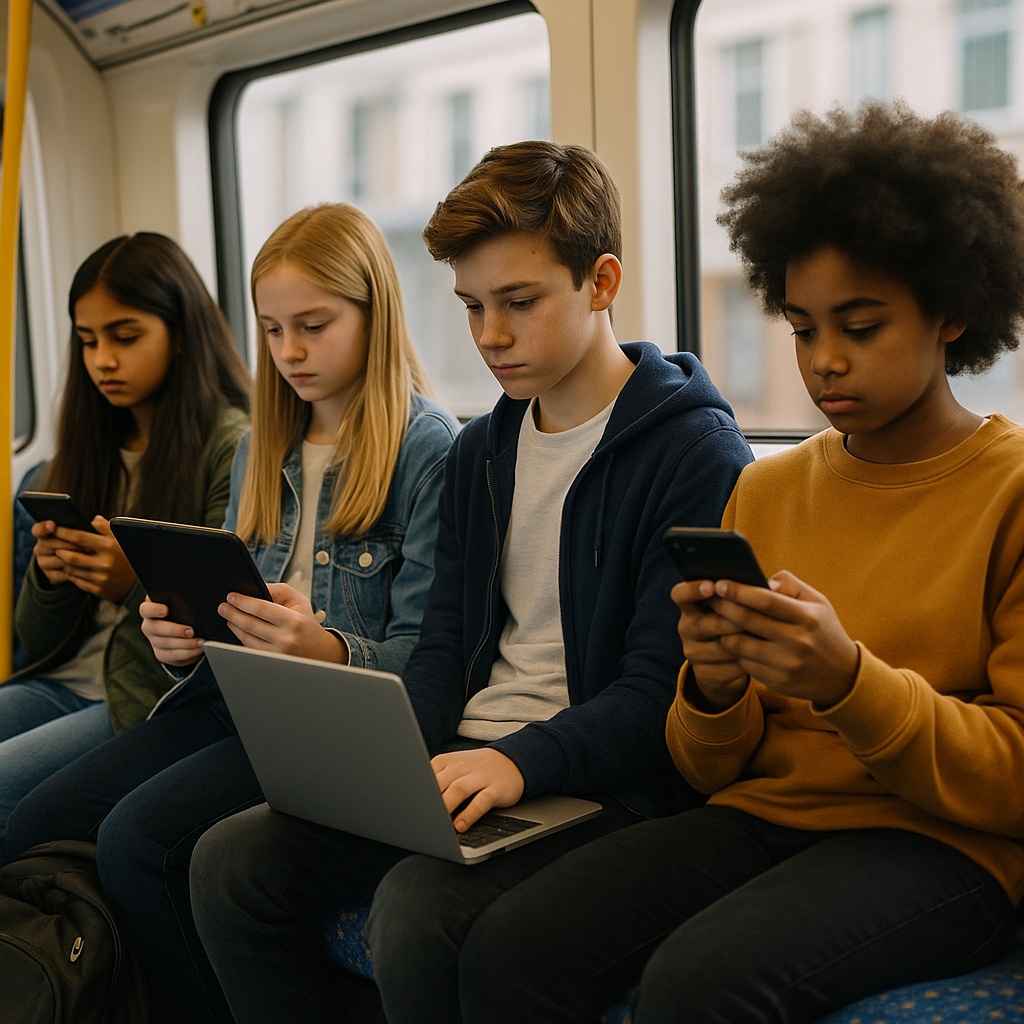The Screen-Obsessed Learner
I live in London, and every morning, as I take my children to school on the Tube, I notice the other kids crammed into the rush hour: toddlers in strollers, kindergartners, school-aged students, university goers – all staring at their screens. No conversation, no interaction. Just tired eyes and passive consumption. Hardly a spark of joy or curiosity. Is any real learning happening here? Or has learning become something we absorb rather than something we actively engage with?
The rise of digital learning – and more recently, its fusion with AI – has been nothing short of revolutionary. But it has also created a paradox: while access to knowledge has never been easier, true learning skills – the ability to process, apply, and think critically – are on the decline (1). Schools and educators increasingly rely on digital tools. But we must ask ourselves: are we giving students the right strategies to learn how to learn?
Screen use and learning strategies
This article does what I’ve been doing for the past few years – diving into research to explore how we can better align screen use and learning strategies with the realities of classrooms and schools. Learning strategies are my passion, and I’m excited to share why it’s time to rethink digital learning – and why true learning for life takes more than just a touchscreen.

No conversation, no interaction. Just tired eyes and passive consumption. Is any real learning happening here? Or has learning become something we absorb rather than something we actively engage with?
The Limits of Digital Learning: Absorbing vs. Engaging
Passive Consumption: The Risk of Screen-Only Learning
Scrolling, tapping, watching – digital learning often prioritises convenience over engagement. Students can access unlimited educational content, yet research shows that consuming information passively leads to lower retention rates. A study from the Handbook of Children and Screens highlights that digital learning often lacks the deep cognitive engagement needed for real understanding (2). If you’re curious about how screens impact learning, this handbook is a must-read—it’s free and packed with eye-opening insights!
Off-Screen Thinking: Developing Real Learning Skills
Studies show that offline cognitive engagement – such as problem-solving without a digital aid – enhances memory and comprehension (3). Writing by hand, discussing ideas in groups, and applying knowledge in hands-on projects all reinforce learning far more effectively than passively watching a video. That’s why every enduri learning strategy is designed to work just as well offline as online. Whether it’s a discussion, a problem-solving task, or a creative project, learning shouldn’t depend on a screen. By integrating off-screen learning approaches, enduri ensures that students develop skills they can apply in multiple contexts, making learning adaptable, engaging, and truly effective.
Learning with Others: Why Collaboration is Key
Communication and Cooperation: The Limits of Automation
One of the biggest gaps in digital learning is human interaction – or, as one of my AI-enthusiast teacher friends put it: “The real risk with AI and digital learning? Your students might end up feeling lonely.” AI-driven platforms provide instant feedback, but they often fall short when it comes to fostering real discussion, encouraging debate, and refining arguments – skills that only develop through meaningful peer interaction. Research from the Cornell Centre for Teaching Innovation found that students engaged in collaborative learning build stronger reasoning and critical thinking abilities than those learning in isolation (4).
True 21st-century learning isn’t just about accessing information – it’s about how we engage with it. The 4Cs – Communication, Collaboration, Critical Thinking, and Creativity – are at the heart of meaningful learning, yet they can’t be fully developed through screens alone. That’s why enduri creates learning experiences that spark discussion, encourage negotiation, and foster teamwork. Students are not just absorbing knowledge – they’re learning how to think, adapt, and collaborate for life.
Learning with Peers: The Role of Face-to-Face Interaction
When learning happens solely through digital mediums, students miss the chance to develop interpersonal skills. A simple discussion about a history topic or a group project in science fosters deeper understanding than any pre-recorded lesson. enduri’s blended learning approach ensures that offline learning complements digital tools, helping students refine their ability to express, argue, and collaborate – critical skills for both academic and professional success.
Critical Thinking and Problem-Solving: Beyond the Algorithm
Questioning Information: The Importance of Critical Thinking
Digital learning platforms often provide structured answers, but they rarely challenge students to think critically. With AI-generated responses and automated grading, learners can complete tasks quickly – but without deeper analysis. A study in the OECD Education Research Journal found that students engaged in problem-based learning significantly outperformed those relying solely on digital education when tackling real-world challenges (5). I firmly believe that real learning goes beyond memorisation – it thrives on critical thinking. That’s why one of enduri’s core missions is to empower learners to question, analyse, and reflect, ensuring they develop the skills to think independently and navigate complex problems with confidence.
Off-Screen Problem-Solving: Applying Learning Beyond the Digital World
A key goal of education is to prepare students for real-life challenges. Yet relying too heavily on digital platforms often limits exposure to off-screen applications of knowledge.Here’s an example I like to use:
Think about it – what memory strategy do you use so you never need a grocery list? How do you break down and truly understand a complex newspaper article? And could you develop a groundbreaking idea without digital tools? Real-world learning isn’t just about accessing information—it’s about applying it..
That’s why enduri integrates project-based learning, where students take on challenges that demand hands-on application, creative problem-solving, and adaptive thinking. By engaging in these experiences, they don’t just consume knowledge – they learn how to use it, a skill that stays with them for life.
Individualised Learning Strategies: One Size Does Not Fit All
Content-Independent and Curriculum-Adaptable
One of enduri’s greatest strengths is its flexibility. Unlike many learning platforms that prescribe fixed curricula, enduri is content-independent, meaning it can be adapted to any educational system, teaching approach, or subject matter. Whether you follow a national curriculum, an alternative learning framework, or a self-directed learning path, enduri provides personalised strategies that fit the needs of learners, regardless of their background or educational structure.
The Power of Personalised Learning
Traditional education often treats all students the same, expecting them to progress at the same pace. However, learning is highly individualised. Some students grasp concepts quickly, while others need more time. Rigid digital platforms can struggle to accommodate these differences. Research from Cognitive Science in Education confirms that personalising learning pathways improves engagement and retention (6).
Why enduri Makes the Difference
At enduri, we champion individualised learning strategies that help students learn to learn. Our approach is clear, direct, and results-driven:
- Project-Based Learning: Learners tackle hands-on challenges that require creativity and real-world problem-solving.
- Hybrid Learning Approach: We balance digital tools with offline experiences, so students develop versatile learning skills.
- Critical Thinking Training: Our activities push learners to question, debate, and analyse, moving beyond memorisation to mastery.
- Collaboration Focus: We encourage students to engage with peers, exchange ideas, and refine their reasoning.
At enduri, we believe learning is a skill, not just a task. We help learners build habits that make them independent thinkers, equipping them with the tools they need for success beyond the classroom.
The Future of Learning: A Balanced Approach
A Hybrid Model: Blending Digital and Off-Screen Learning
The future of education isn’t about rejecting technology—it’s about balancing it. A hybrid learning model, where digital tools complement off-screen experiences, ensures students gain both technological literacy and deep learning skills. At enduri, our approach embraces the best of both worlds. Our learning strategies (check out our dedicated page on enduri.org) combine digital flexibility with offline engagement, ensuring that students are active participants in their education.
Call to Action: Be the Change in Learning
As I sit on the tube, watching students absorbed in their screens, I wonder: will the future of learning look the same? Or can we take control and shape it differently?
I believe deeply in equipping learners with the strategies to succeed beyond the digital realm. If you want to explore individualised learning strategies that prioritise engagement, visit enduri.org and become part of a community that values real learning.
Sources
- UCLA Newsroom – Is Technology Producing a Decline in Thinking Skills? Read more
- ResearchGate – The Erosion of Cognitive Skills in the Technological Age Read more
- Cornell University – Active and Collaborative Learning Strategies Read more
- Cornell University – Problem-Based Learning: Enhancing Critical Thinking Read more
- Cornell University – Active Learning: Personalising Education Pathways Read more

